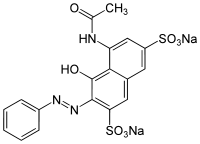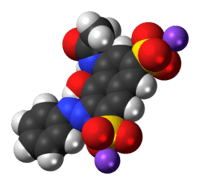Red 2G
 | |
 | |
| Names | |
|---|---|
| Other names
Acid Red 1 Food Red 10 Amidonaphthol red G azogeranine azophloxine azofloxin C.I. 18050 | |
| Identifiers | |
| 3734-67-6 | |
| 3D model (Jmol) | Interactive image |
| ChemSpider | 21106472 |
| ECHA InfoCard | 100.020.999 |
| E number | E128 (colours) |
| |
| |
| Properties | |
| Molar mass | 509.43 g/mol |
| Except where otherwise noted, data are given for materials in their standard state (at 25 °C [77 °F], 100 kPa). | |
| | |
| Infobox references | |
Red 2G is a synthetic red azo dye. It is soluble in water and slightly soluble in ethanol. It usually comes as a disodium salt of 8-acetamido-1-hydroxy-2-phenylazonaphthalene-3,6 disulphonate.
Uses
Food dye
In the European Union, Red 2G was used as a food dye (E number E128). However, it was only permitted for use in breakfast sausages with a minimum cereal content of 6% and burger meat with a minimum vegetable and/or cereal content of 4%.[1]
Following safety concerns raised by EFSA in its opinion of 5 July 2007,[2] the European Commission has prepared a draft Regulation to suspend use of E128 as a food colouring. This proposed course of action was unanimously approved by European Union Member States at a meeting of the Standing Committee of the Food Chain and Animal Health (Section Toxicological Safety of the Food Chain) on 20 July 2007.[3] and Commission Regulation (EC) No 884/2007 .[4] on emergency measures suspending the use of E 128 Red 2G as food colour was published in the Official Journal of the European Union on 27 July 2007.
Red 2G is also banned in Australia, Canada, Japan, Norway,[5] and Malaysia.[6] It was banned in Israel in July 2007 .
It is relatively insensitive to the bleaching effect of sulfur dioxide (E220) and sodium metabisulfite (E223). In the intestines, Red 2G can be converted to the toxic compound aniline,[7] so there are concerns Red 2G may ultimately interfere with blood haemoglobin, as well as cause cancer.
Inks
It is also used as a dye for coatings, inks, paper, crepe paper, and fine tissue.
Histology
Red 2G can be also used for staining in histology, though rarely, e.g. as a component of Masson's trichrome.
Health risks
It is one of the colourants that the Hyperactive Children's Support Group recommends be eliminated from the diet of children.
In July 2007 the EFSA established E128 is potentially carcinogenic as it forms aniline in the body when consumed.[8]
The pressure group, The Food Commission, said there had been concerns about Red 2G going back decades and it was suspected of being a carcinogen in the 1980s.[9]
References
- ↑ European Parliament and council directive 94/36/EC of june 1994 on colours for use in foodstuffs
- ↑ EFSA announcement
- ↑ Sanco -E
- ↑ http://eur-lex.europa.eu/LexUriServ/LexUriServ.do?uri=OJ:L:2007:195:0008:0009:EN:PDF
- ↑ Mattilsynet
- ↑ Dye used in burgers and sausages banned
- ↑ Hickman, Martin (10 July 2007). "Additive used in sausages and burgers may cause cancer". The Independent. London. Archived from the original on 2008-05-22. Retrieved 22 May 2010.
- ↑ 'Sausage additive linked to cancer' - BBC News
- ↑ Hickman, Martin (10 July 2007). "Additive used in sausages and burgers may cause cancer". The Independent. London. Retrieved 2007-07-10.